1900-1909 selected standards and hits
___________________________________
 1901
1901
Hello Central, Give Me Heaven (Charles K. Harris)
1902
(Won’t You Come Home) Bill Bailey (Hughie Canon)
The Entertainer (Scott Joplin)
In the Good Old Summertime (George Evans, Ren Shields)
1903
Toyland (Victor Herbert, Glen McDonough)
1904
Give My Regards to Broadway (George M. Cohan)
The Yankee Doodle Boy (George M. Cohan)
 1906
1906
You’re a Grand Old Flag (George M. Cohan)
Anchors Aweigh (m. Charles A. Zimmerman, w. Alfred Hart Miles, Royal Lovell)
1907
School Days (Gus Edwards, Will D. Cobb)
Red Wing (Kerry Mills)
1908
Shine On Harvest Moon (m. Nora Bayes, Jack Norworth, w. Jack Norworth)
Take Me Out to the Ballgame (Albert Von Tilzer, Jack Norworth)
1909
By the Light of the Silvery Moon (Gus Edwards, Edward Madden)
See also, internal:
- Irving Berlin: selected early songs, 1907-1914 + sheet music gallery
- Irving Berlin: selected songs of 1909 and 1910
external:
1901
Hello Central, Give Me Heaven (Charles K. Harris)
 In 1901 Charles K. Harris, known as “King of the Tearjerkers,” and most famous for his enormous 1892 hit After the Ball, composed and published “Hello Central, Give Me Heaven.” ParlorSongs.com has a fine feature on the music of Charles K. Harris, here: part 1, part 2. The song was recorded in a country style by the Carter Family in 1934. It later became a standard in both the country gospel and bluegrass genres.
In 1901 Charles K. Harris, known as “King of the Tearjerkers,” and most famous for his enormous 1892 hit After the Ball, composed and published “Hello Central, Give Me Heaven.” ParlorSongs.com has a fine feature on the music of Charles K. Harris, here: part 1, part 2. The song was recorded in a country style by the Carter Family in 1934. It later became a standard in both the country gospel and bluegrass genres.
Video provider EdisonSquirrel says:
“Hello Central, Give Me Heaven” was originally recorded by Byron G. Harlan on Edison brown wax cylinder No. 7852 [,which] was released in July 1901. Harlan rerecorded the song on a black wax cylinder about a year later and it was released under the same number.
It’s not clear which version this one is.
________________
1902
(Won’t You Come Home) Bill Bailey — words and music by Hughie Canon (1877-1912)
 According to Wikipedia, the song was originally titled “Bill Bailey, Won’t You Please Come Home?,” and is commonly referred to as simply “Bill Bailey.”
According to Wikipedia, the song was originally titled “Bill Bailey, Won’t You Please Come Home?,” and is commonly referred to as simply “Bill Bailey.”
From the Wikipedia page:
Its words and music were written by Hughie Cannon (1877–1912), an American songwriter and pianist. It is still a standard with Dixieland and traditional jazz bands. The simple 32-bar chord sequence of its chorus also underpins many other tunes played mainly by jazz bands, such as “Over the Waves”, “Washington and Lee Swing”, “Bourbon Street Parade”, “My Little Girl”, and the final themes of “Tiger Rag” and “The Beer Barrel Polka”.
Cannon wrote the song in 1902 when he was working as a bar pianist at Conrad Deidrich’s Saloon in Jackson, Michigan. Willard “Bill” Bailey was a regular customer and friend, and one night told Cannon about his marriage to Sarah (née Siegrist). Cannon “was inspired to rattle off a ditty about Bailey’s irregular hours. Bailey thought the song was a scream [i.e. very good], and he brought home a dashed-off copy of the song to show Sarah. Sarah couldn’t see the humor…. [but] accepted without comment the picture it drew of her as a wife.” Cannon sold all rights to the song to a New York publisher, and died from cirrhosis aged 35. Willard and Sarah Bailey later divorced; he died in 1954, and she died in 1973.[1]
Parlor Songs says:
Supposedly, the song is based on a “real” Bill Bailey who was a black vaudeville performer, member of the team of Bailey and Cowan. One night he was locked out of his house by a wife who had reached her limit of tolerance for his late night revelry with friends. It is said that Cannon (the composer) was one of his friends who partook of these nocturnal pleasures with him and Cannon paid for a room for Bailey at a local hotel and assured him that a night away from home would surely cause his wife to plead for his return.
_____________
Arthur Collins — originally issued on the 1902 cylinder Columbia Phonograph Co. 31786
.
Beatrice Kay with the Eligibles — from the 1962 album Beatrice Kay Sings Gay ’90s, Tops Records L 1655, Mayfair Records 9655S
The band begins with very simple accompaniment but really cooks in a break after the first chorus.
_____________________
The Entertainer (Scott Joplin)
From Wikipedia:
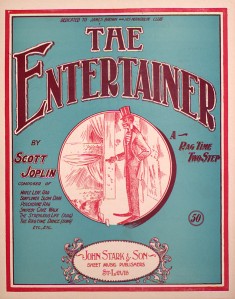 One of the classics of ragtime, it returned to top international prominence as part of the ragtime revival in the 1970s, when it was used as the theme music for the 1973 Oscar-winning film The Sting.
One of the classics of ragtime, it returned to top international prominence as part of the ragtime revival in the 1970s, when it was used as the theme music for the 1973 Oscar-winning film The Sting.
Links to sheetmusic and midi files provided by Wikipedia:
- Musical score and MIDI file at the Mutopia Project
- Sheet music and mp3 at mfiles.co.uk (interactive version requires Sibelius Scorch)
- Free MP3 Download and video
- Free typeset sheet music from Cantorion.org.
Piano roll, undated, with slide show tribute to the composer — The video provider seems to suggest that Scott Joplin played the piano in the creation of this roll, but that’s not clearly stated.
___________________
In the Good Old Summertime (George Evans, Ren Shields)
 Sheilds and Evans were at first unsuccessfully trying to sell their song to one of New York’s big sheet music publishers. The publishers thought the topic of the song doomed it to be forgotten at the end of the summer season. Blanche Ring, who had helped Evans arrange the number’s piano score, was enthusiastic about it and at her urging it was added to the 1902 musical comedy show “The Defender” she was appearing in. The song was a hit from the opening night, with the audience often joining in singing the chorus.[2]
Sheilds and Evans were at first unsuccessfully trying to sell their song to one of New York’s big sheet music publishers. The publishers thought the topic of the song doomed it to be forgotten at the end of the summer season. Blanche Ring, who had helped Evans arrange the number’s piano score, was enthusiastic about it and at her urging it was added to the 1902 musical comedy show “The Defender” she was appearing in. The song was a hit from the opening night, with the audience often joining in singing the chorus.[2]
“In the Good Old Summer Time” was one of the big hits of the era, selling popular sheet music and being recorded by various artists of the day, including John Philip Sousa’s band in 1903. It has remained a standard often revived in the decades since. – Excerpt from Wikipedia, adapted
piano roll
Haydn Quartet – recorded 10 May 1906
__________________
1903
Toyland (Victor Herbert, Glen McDonough) — featured in the operetta Babes in Toyland
From Wikipedia:
Babes in Toyland is an operetta composed by Victor Herbert with a libretto by Glen MacDonough (1870–1924), which wove together various characters from Mother Goose nursery rhymes into a Christmas-themed musical extravaganza. Following the extraordinary success of their stage musical The Wizard of Oz, which was produced in New York beginning in January 1903, producer Fred R. Hamlin and director Julian P. Mitchell hoped to create more family musicals.[1] MacDonough had helped Mitchell with revisions to the Oz libretto by L. Frank Baum. Mitchell and MacDonough persuaded Victor Herbert to join the production.[citation needed] Babes in Toyland features some of Herbert’s most famous songs – among them “Toyland”, “March of the Toys”, “Go To Sleep, Slumber Deep”, and “I Can’t Do the Sum”. The theme song “Toyland”, and the most famous instrumental piece from the operetta, “March of the Toys”, occasionally show up on Christmas compilations.
The original production opened at the Chicago Grand Opera house in June 1903, produced by Hamlin and directed by Mitchell, and toured to several East Coast cities before opening in New York in October 1903 and ran for 192 performances. This was followed by many successful tours and revivals. The piece was so popular that it spawned other “fairy-tale” shows over the next decade.[2]
Hadyn Quartet, with vocal by Corinne Morgan — recorded on 25 March 1904; issued on the 10″ single-faced disc Victor 2721 (matrix B-1166) — The Discography of American Historical Recordings suggests that two of the three known takes recorded on 25 March 1904, and assigned matrix number B-1166, were released separately on 10″ single-faced records under the catalog number Victor 2721, though the session date is marked “unconfirmed.”
______________________
1904
Give My Regards to Broadway (George M. Cohan) was composed by Cohan for his original Broadway musical Little Johnny Jones which opened in 1904.
Wikipedia excerpts:
 The show was Cohan’s first full-length musical. A famous American jockey, Tod Sloan, had gone to England in 1903 to ride in the Derby for the King of England. This gave Cohan the idea for the story. The musical is jingoistic in tone, containing a lot of anti-European quips, like “You think I’d marry an heiress and live off her money? What do you take me for? An Englishman?” And: “French pastry ain’t worth 30¢ compared to American apple pie.” In Little Johnny Jones, Cohan introduced some of the dance steps and comedy features for which he would become famous.[1]
The show was Cohan’s first full-length musical. A famous American jockey, Tod Sloan, had gone to England in 1903 to ride in the Derby for the King of England. This gave Cohan the idea for the story. The musical is jingoistic in tone, containing a lot of anti-European quips, like “You think I’d marry an heiress and live off her money? What do you take me for? An Englishman?” And: “French pastry ain’t worth 30¢ compared to American apple pie.” In Little Johnny Jones, Cohan introduced some of the dance steps and comedy features for which he would become famous.[1]
Cohan, playing the title character, sings this song as his friend is about to sail to America, looking for evidence aboard ship that will clear his name for allegedly throwing the English Derby.
The sentimental song has been recorded many times. It was featured prominently in a solo song-and-dance sequence done by James Cagney in his Oscar-winning performance in the 1942 film about Cohan’s life, Yankee Doodle Dandy.
Billy Murray – 1905. Victrola performance and video provided, with an introduction, by victrolaman
.
James Cagney and chorus
soundtrack from the film Yankee Doodle Dandy (1942)
.
(below) in Yankee Doodle Dandy
___________________
The Yankee Doodle Boy (George M. Cohan)
Billy Murray – 1905
.
James Cagney and chorus in the film Yankee Doodle Dandy (1942)
_______________________
1906
You’re a Grand Old Flag (George M. Cohan)
See the separate feature page:
___________________
Joe Holt — uploaded on 5 Jun 2009
__________________
 Anchors Aweigh (m.Charles A. Zimmerman, w. Alfred Hart Miles, Royal Lovell)
Anchors Aweigh (m.Charles A. Zimmerman, w. Alfred Hart Miles, Royal Lovell)
Wikipedia:
Anchors Aweigh is the fight song of the United States Naval Academy, and strongly associated with the United States Navy, composed in 1906 by Charles A. Zimmerman with lyrics by Alfred Hart Miles. Zimmerman was at the time a Lieutenant, and had been bandmaster of the United States Naval Academy Band since 1887. Miles was Midshipman First Class at the Academy, in the class of 1907, and asked Zimmerman to assist him in composing a song for that class, to be used as a football march. Another Academy Midshipman, Royal Lovell (class of 1926) later wrote what would be adopted into the song as its third verse.
Anchors Aweigh Medley by the USNA Men’s Glee Club. Performed in San Antonio, TX at the Basilica of the Shrine of the Little Flower, March 11, 2008.
__________________
1907
School Days (Gus Edwards, Will D. Cobb) — The opening of the refrain bears a striking resemblance to that of Victor Herbert’s “Toyland” (1903).
Byron G. Harlan — 1907 recording
- Byron G. Harlan — Wikipedia
____________________
(right) John S. MacDonald (Harry Macdonough)
Red Wing (Kerry Mills)
S. H. Dudley and Harry Macdonough – 1907
.
Shannon Quartet – c.1926
_________________________
1908
 Shine On Harvest Moon (m. Nora Bayes, Jack Norworth, w. Jack Norworth)
Shine On Harvest Moon (m. Nora Bayes, Jack Norworth, w. Jack Norworth)
Excerpt from the Wikipedia article:
The song was debuted by Bayes and Norworth in the Ziegfeld Follies of 1908 to great acclaim. It became a pop standard, and continues to be performed and recorded even in the 21st century.
During the vaudeville era, songs were often sold outright, and the purchaser would be credited as the songwriter. John Kenrick‘s Who’s Who In Musicals* credits the song’s actual writers as Edward Madden and Gus Edwards. However, David Ewen’s All the Years of American Popular Music credits Dave Stamper, who contributed songs to 21 editions of the Ziegfeld Follies and was Bayes’ pianist from 1903 to 1908.[1]
___________________
Ada Jones and Billy Murray – issued on Edison Standard Record 10134, in 1909
.
Carter’s Orchestra — issued in 1927 on the 78 rpm single (US and Australia) Brunswick 3681, b/w “Breeze (Blow My Baby Back to Me)”; both sides recorded on 10 September 1927
.
Hal Kemp and his Orchestra – 1929
.
The Boswell Sisters – 28 August 1931, NY – Dorsey Brothers Orchestra: Mannie Klein (tpt) Tommy Dorsey (tbn) Jimmy Dorsey (cl, as) unknown (vln) Martha Boswell (p) Eddie Lang (g) Joe Tarto (sb) Stan King (d) New York
_______________
Ruth Etting – 19 July 1935
_____________________
Take Me Out to the Ballgame (Albert Von Tilzer, Jack Norworth)
 “Take Me Out to the Ballgame” is a popular early 20th century song which became the unofficial anthem of baseball although neither of its authors had attended a game prior to writing the song.[1] The song is traditionally sung during the seventh-inning stretch of a baseball game. Fans are encouraged to sing along.
“Take Me Out to the Ballgame” is a popular early 20th century song which became the unofficial anthem of baseball although neither of its authors had attended a game prior to writing the song.[1] The song is traditionally sung during the seventh-inning stretch of a baseball game. Fans are encouraged to sing along.
The words were written in 1908 by Jack Norworth, who while riding a subway train, was inspired by a sign that said “Baseball Today — Polo Grounds”. The words were set to music by Albert Von Tilzer, (Norworth and Von Tilzer finally saw their first Major League Baseball games 32 and 20 years later, respectively). The song was first sung by Norworth’s wife Nora Bayes and popularized by various vaudeville acts. Norworth wrote an alternative version of the song in 1927. (Norworth and Bayes were famous for writing and performing such smash hits as “Shine On, Harvest Moon.”)[2][3]
With the sale of so many records, sheet music, and piano rolls, the song became one of the most popular hits of 1908. The Haydn Quartet singing group, led by popular tenor Harry MacDonough, recorded a successful version on Victor Records.[4]
Two other recorded renditions were somewhat popular that year as well. Harvey Hindermyer, a member of the Shannon Four singing group and a popular radio performer later in life, recorded the song for Columbia Records. That version can be found on the Ken Burns Baseball documentary soundtrack. Another hit version was recorded by Edward Meeker, staff announcer and special effects man for Edison Records. – from Wikipedia, slightly amended
Edward Meeker – recording of September 1908, Edison. Original lyrics.
.
Harry Caray and Chicago Cubs fans at Wrigley Field, 1985
.
As with many successful songs of the time there were follow-ups attempting to cash in on the popularity of the original with a different spin on the same theme.
___________________
By the light of the silvery moon
I want to spoon
To my honey I’ll croon love’s tune
Honey moon, keep a-shinin’ in June
Your silv’ry beams will bring love’s dreams
We’ll be cuddlin’ soon
By the silvery moon
By the Light of the Silvery Moon (Gus Edwards, Edward Madden)
Clark Gable and chorus in the film Idiot’s Delight (1939)
.
Fats Waller & his Rhythm – 1942 (possibly 13 July)
.
Doris Day and Gordon MacRae duet in the film By the Light of the Silvery Moon (1953)
_________________________
* From the Nora Bayes bio in the section Who’s Who In Musicals: A to Ba of John Kenrick’s website Musicals 101:
She scored [sic] in Florenz Ziegfeld‘s first Follies (1907) and returned for the 1908 edition, singing the smash-hit “Shine On Harvest Moon,” which she supposedly co-wrote with her third husband, composer Jack Norworth (In fact, the song was composed by songwriters Edward Madden and Gus Edwards).

























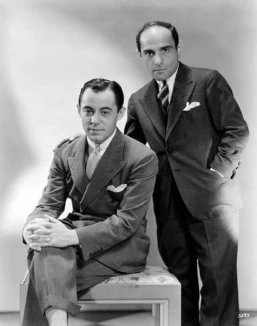

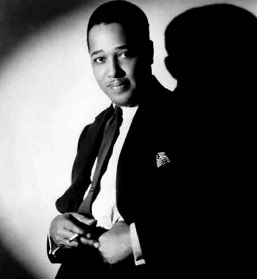


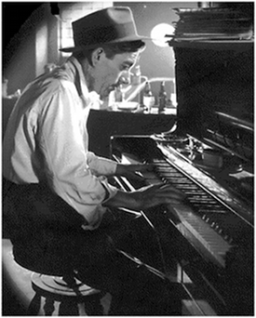
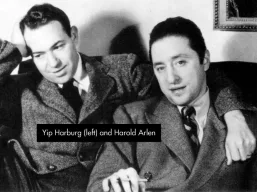




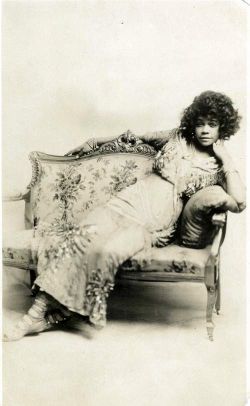










Feb 02, 2012 @ 08:51:25
Thank you so much! This website is a goldmine for my popular music class!
LikeLike
Sep 13, 2016 @ 12:55:52
Sarah,
You’re welcome. Ordinarily, it takes me fewer than 4 1/2 years to respond to a comment. Sorry for the delay. : )
Regards,
doc
LikeLike
Sep 21, 2017 @ 09:06:04
You put the ‘pro’ in ‘procrastination’
LikeLike
Aug 22, 2018 @ 16:48:40
What a great compilation, thank you so much!!
LikeLike
Aug 23, 2018 @ 14:24:29
Roberta,
Thanks. Very kind of you!
doc
LikeLiked by 1 person